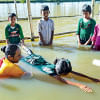A neglected national crisis

Drowning, although a relatively less-discussed cause of death, is a major global killer, particularly of children and young adults. According to the World Health Organization's (WHO) 2017 data, over 360,000 people die from drowning each year, with 90 percent of the deaths occurring in low- and middle-income countries. Alarmingly, it is the third major cause of death worldwide for children aged between five and 14 years, even more than deaths from congenital anomalies, leukaemia, lower respiratory infections, epilepsy, dengue, and meningitis. Globally, the highest drowning rates are among children aged one to four years, followed by children aged five to nine years. Drowning deaths can be prevented by undertaking programmes and policies that address known risk factors. However, this is still nascent in many developing countries, including Bangladesh.
According to the Health and Injury Survey (BHIS) survey conducted in 2016, every year at least 14,438 children (0-17 years) die from drowning. This translates to 43 child deaths from drowning per day. For young children, all water receptacles (be it a bucket, bathtub, pond, or pool) could cause them to drown. A 2022 study by Hossain et al suggested that, in Bangladesh, around 80 percent of drowning deaths occur due to exposure to ponds, channels, buckets, and ditches within 20 metres of a victim's home. Six major reasons behind drowning deaths, according to WHO, are 1) lack of physical barriers between people and water; 2) lack of (or inadequate) supervision of young children; 3) uncovered or unprotected water supplies and lack of safe water crossings; 4) lack of water safety awareness and risky behaviour around water, such as swimming alone; 5) travelling on water, especially on overcrowded or poorly maintained vessels; and 6) flood disasters.
But a less-talked-about cause behind drowning can be parents' or communities' misconceptions regarding when or how drowning could happen to children. Some may feel that their children are immune to drowning because they are good parents, but without layers of protection, no child is safe from this tragedy. Even knowing how to swim may not be enough to protect a child against drowning, as falling into a water body alone makes for a very different situation than what the child has experienced during monitored swimming lessons in pools. Even indoors, it is crucial to keep an eye on younger children as they move fast and could easily get in a dangerous situation. One may also think that if their child does fall into a water body, they would be able to observe signs and rescue them. Unfortunately, drowning is a silent event, and drowning children usually cannot splash around, cry, or call out for help.
As such, the WHO also outlined six interventions to prevent child drownings: providing safe places away from water for preschool-aged children; installing barriers controlling access to water; providing children with swimming and water safety skills; building resilience and managing flood risks; training bystanders in safe rescue and resuscitation; and setting up and enforcing safe boating, shipping, and ferry regulations.
To implement these interventions successfully, some strategies are needed, such as promoting multi-sectoral collaboration, strengthening public awareness of drowning through strategic communication, establishing a national water safety plan, and advancing drowning prevention through data collection and well-designed studies.
An injury and drowning prevention programme was implemented between 2006 and 2010 in three rural sub-districts namely Raiganj, Sherpur, and Manohordi, which found that community daycare centres (such as Anchal) and survival-oriented swimming lessons for children (such as SwimSafe) can be very cost-effective. The findings from several other pilot interventions also suggest that playpens and community creches are effective in preventing drowning in children under five years of age.
The government of Bangladesh has undertaken some drowning prevention actions in its recent child protection strategies. However, due to funding constraints, lack of logistics and other socio-cultural factors, it will take a long time to implement the aforementioned interventions and drowning prevention strategies countrywide. To this end, the cost-effective and voluntary activities outlined above need to be scaled up in partnership with local residents and other organisations including the government, NGOs, CBOs, and the private sector.
Dr Edris Alam teaches in the Department of Geography and Environmental Studies at the University of Chittagong, Bangladesh. Email: [email protected]


 For all latest news, follow The Daily Star's Google News channel.
For all latest news, follow The Daily Star's Google News channel. 










Comments